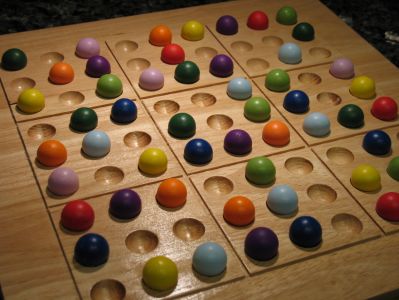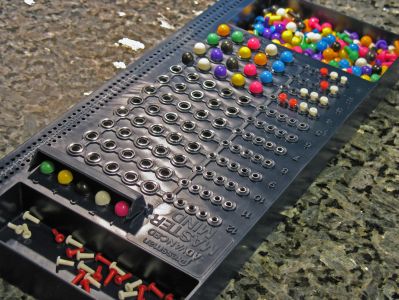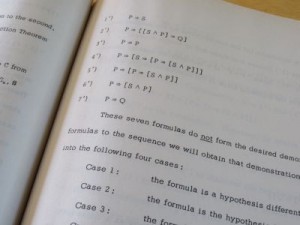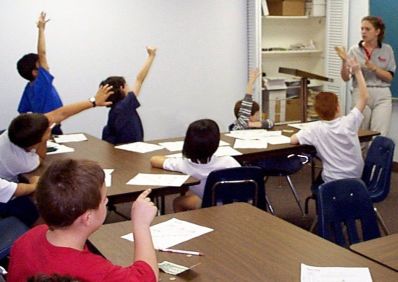
Adam Sternberg began his path to engineering as part of Project MEGSSS in Broward County, Florida. (The principal curriculum developers and teachers for the Florida MEGSSS program founded IMACS in 1993 using the same Elements of Mathematics courses.) He went on to earn his B.S. in Electrical Engineering from the University of Maryland College Park and his M.S. in Electrical Engineering with a concentration in Digital Signal Processing from Florida Atlantic University. In his role as a software engineer for innovative companies such as AlliedSignal (now Honeywell) and RadiSys, Adam was responsible for developing software used with flight navigation tools and telecommunications products. He is currently a senior software engineer at Pace Americas. In his spare time, Adam has even been a volunteer teacher, sharing his knowledge of computer programming and university-level logic with elementary school students.
You were part of the first group of students in the Broward County MEGSSS program. What were your thoughts when you started progressing through the curriculum?
The MEGSSS curriculum (which has now evolved into the IMACS curriculum) was different from anything I had seen previously. In the standard honors math class, my friends were mainly doing more of the same material as the regular class at a faster pace. In MEGSSS, we covered the expected topics, but the majority of the time was spent learning concepts that students usually don’t see until college. In most math classes, theorems are stated as fact, and then students are expected to apply them. In MEGSSS, learning how to prove those theorems from principles proven earlier was an essential part of our education and resulted in us having a deep understanding and appreciation of the subject.
What knowledge and perspective did you gain during that time that influenced the career path that you took?
The subject matter from MEGSSS that helped the most was logic (predicate calculus). I found I always had an affinity with logic and the structure of proofs, and that made me comfortable with the process of coding in a high-level language, such as C or Perl. The MEGSSS/IMACS experience in general, with its emphasis on logical proofs building on previous theorems and axioms to explore new topics, evolved into an ordered approach to problem-solving that is the hallmark of a good engineer of any discipline.
Please describe what a software engineer does, big picture and day-to-day.
A software engineer is responsible for the design, implementation, and maintenance of a software product, whether it be a Web site, an app for a smartphone, or the radar on an airplane. This includes designing proper test cases for the product, and identifying and correcting bugs found in the product code. Software engineers are also often called on to make judgment calls in triaging bugs found during a test cycle and determining both the severity and the likelihood of a bug appearing in the field with a released product. As software and the equipment they run on are rapidly evolving, software engineers must also make sure that they are familiar with the latest trends in programming languages, algorithms, tools, and related technology.
In your experience, what kind of personality and/or non-technical skills makes a person well-suited to be a software engineer?
Good communication skills are vital to be able to explain technical details to a non-technical audience (such as customers or the sales team) because software engineers often work in a corporation and not a vacuum. Also, good detective skills (such as observing behavioral patterns) are vital to finding bugs. Finally, no one’s code is perfect, and colleagues and supervisors will find fault with an engineer’s design or code in a review, so a thick skin is also helpful.
What education, skills and training make for success in the job?
A Bachelor’s degree in Computer Science, Computer Engineering, or related field (such as Electrical Engineering) is vital, and a Master’s Degree is often preferred. As an engineer’s career progresses, tasks may become more senior in nature, so leadership, project management, and even mentoring skills are good to have. Structured problem-solving skills, like what students develop at IMACS, and solid design skills are vital.
This week, IMACS catches up with an old friend, Mark Engelberg. Mark was part of the inaugural class of Project MEGSSS students in Broward County, Florida, when that program began in 1983. MEGSSS (Mathematics Education for Gifted Secondary School Students) was an ambitious public school course of study with a curriculum designed specifically for the brightest math students. The Broward program became IMACS in 1993. Like many of his fellow MEGSSS/IMACS alumni, Mark went on to an accomplished career in a STEM-related field. He is known for having designed the bestselling logic game, Chocolate Fix, as well as adding thousands of new challenges to the popular Rush Hour game.
How did Chocolate Fix evolve from an idea to a bestselling game to the basis for a new logic curriculum?
Chocolate Fix started out as a product called Gridworks. Gridworks was my first collaboration with ThinkFun, and its creation was very much a team effort. Bill Ritchie, the CEO of ThinkFun, had the initial inspiration to build a visual logic puzzle system. I proposed the pattern-matching framework for the clues and made the case that such a system would be simple, elegant, and expressive. Two very brilliant and prolific puzzle designers, Serhiy Grabarchuk Jr. and Scott Kim, ran with the idea and came up with the initial book of 60 puzzles. And of course, ThinkFun’s excellent artists and graphic designers came up with the product’s look and feel. It was a real thrill to work with so many talented individuals.
The funny thing, looking back, is that at the time, we weren’t entirely certain whether such a clue system would be rich enough to create challenging and interesting puzzles. Yet nearly a decade later, we haven’t even come close to exhausting Chocolate Fix’s potential; we’re constantly discovering clever new types of puzzles that can be expressed within the system.
Meanwhile, Chocolate Fix received the Parents’ Choice Gold Award in 2008, and in 2010, the Bunge Lab at UC Berkeley published a study that named Chocolate Fix as one of a handful of puzzle games that were shown to increase IQ. We know of at least one geometry teacher who has successfully used Chocolate Fix to teach his students the skill of constructing mathematical proofs. This is all exciting stuff, and it looks like Chocolate Fix has a bright future. Right now, we’re looking at ways to combine all the things we’ve learned about Chocolate Fix and turn it into an actual curriculum for teaching logic, problem solving, and mathematical proof skills.
You were also instrumental in using technology to develop thousands of new challenges for the Rush Hour app when the initial thought was that all the “good” challenges were gone. What are your thoughts on how technology continues to affect how we play games?
Technology touches every facet of our lives, and games are no exception. Computer games, for example, now form one of the largest segments of the entertainment industry. Even when it comes to non-electronic games and puzzles, computers play an important role behind the scenes. Nearly every crossword puzzle and sudoku are created these days with the assistance of computers. Artificial intelligence programs continue to shed new light on strategies for the world’s deepest games, including Chess, Go, and Poker. So to me, it seemed perfectly natural to apply my programming skills to the task of creating fresh new Rush Hour challenges.
You are the inventor of two other games – Animalogic and Snorkels. Tell us about them.
Animalogic received the Parents’ Choice Gold Award in 2009. Like Chocolate Fix, it is a solitaire puzzle system that comes with a book of challenges. The premise is that you have to successfully get 16 colored animals across a river, but the animals will only line up behind other animals that match in type or color. It’s a nice spatial, attribute-matching puzzle system with simple rules that even the youngest of kids can understand, but the puzzle book has a full range of difficulty levels, including expert challenges that will give adults a mental workout.
Snorkels is a two-player strategy game where each player controls a team of cute, colorful aliens with the goal of being the first to capture one of your opponent’s aliens. The capturing mechanism in Snorkels comes directly from the ancient Asian strategy game Go, which is widely regarded as the deepest strategy game ever devised (even deeper than Chess!). In fact, I created Snorkels primarily to be a “gateway game” to Go, which happens to be my favorite game. Snorkels is satisfying in its own right, but once you master Snorkels, you’ll find it a snap to learn and enjoy Go.
You recently said that the MEGSSS program, which is now part of the IMACS curriculum, gave you the logical thinking skills that enabled you to develop Chocolate Fix. Can you elaborate on that?
When creating the clue system for Chocolate Fix, I was heavily inspired by my experience with Book 1 of the Elements of Mathematics series, “Introductory Logic.” [Editor’s note: This material now forms the Logic for Mathematics I (LM1) curriculum at IMACS.] In a strong sense, each proof challenge in EM Book 1 is a kind of puzzle, and I wanted to capture that kind of thinking in Chocolate Fix. The partial grid clues are a form of disjunction, and the ability to put multiple constraints within one pattern are a kind of conjunction. (Gridworks also featured negative clues. We removed them from Chocolate Fix to simplify the system, but we hope to bring them back as part of the curriculum we’re developing.) When solving a challenging Chocolate Fix puzzle, you can expect to use Inference by Cases, Indirect Inference, and other techniques now taught in the LM1 course at IMACS.
Describe your career path from when you graduated from MEGSSS to your current work in puzzles and games and curriculum development. Who or what experiences influenced you along the way?
After MEGSSS, I went to Rice University, where I double-majored in Computer Science and Cognitive Sciences. From there, I programmed virtual reality simulations at NASA, and then got into the computer game industry, working at Sierra On-line and Rad Game Tools. These days, I’m primarily a stay-at-home dad, but I continue to dabble in puzzles and games when I have spare time.
With respect to puzzles and games, my biggest influence is my own childhood. I logged a lot of hours playing computer adventure games, solving puzzles in GAMES Magazine, and playing boardgames with friends. I was fortunate in college to find a group of friends with similar interests, and I ended up learning a lot about puzzle construction through our many conversations and brainstorming sessions about what worked and what didn’t. I try to create the kinds of things I would have enjoyed when I was in middle school.
If someone reading this thinks he or she has the next brilliant idea for a game or puzzle, what should he or she do next?
The beauty of the Internet age is that it is so easy to get your idea out there. Learn how to program so you can put together a mobile or Web app to showcase your idea.
Build your future on a solid IMACS foundation. Take our free aptitude test today.
IMACS students in a math enrichment class.
Former IMACS instructor, Brandi Parsell, offers advice on how to address the ultimate question in a way that stimulates logical reasoning and critical thinking skills.
It can be endearing, or at times downright frustrating – that eternal question, “why?”. When bright children discover that single word, they seem to grab onto it and won’t let go. Sometimes the answers are simple, and sometimes we find ourselves at a complete loss for words.
This innocent question, however, is a signal to parents that a child is ready to be challenged to think logically. The creativity is there – we can see it in their everyday play. It is how we encourage that creativity and shape it into critical thought that will form a solid basis for a child’s learning ability.
Critical thinking is one of the hardest subjects to teach older students; any schoolteacher will tell you so. But if you begin to give your children the necessary tools when they are as young as three or four years old, they can develop these skills more easily. When the question of “why” is put once again on the table, the best policy is to ask, don’t tell. Challenge your children; ask what they think the reason might be. Chances are you will be pleasantly surprised.
Often parents believe that when their child reaches school age, he or she will at last find satisfaction for that curiosity. Talented students, though, may become bored with traditional school curriculum. When such a student is not challenged to exceed our expectations, this frustration often takes the form of careless errors and lack of effort. If children begin to develop these kinds of bad habits, too often they give up quickly when faced with a truly challenging problem. It is important that bright students are encouraged to go beyond what is merely “expected” of them.
“Talented students owe it to themselves to stretch their minds as far as they can,” said Burt Kaufman, co-founder of IMACS. Burt spoke from experience. For over 40 years he worked closely with bright pre-college students and developed challenging mathematics curriculum materials to stimulate them to become true students – disciplined logical thinkers with an insatiable thirst for knowledge and understanding.
Parents are a child’s first teachers, and the best teachers don’t give away the answers. Turn your child into a detective, and yourself into their greatest source for clues.
An IMACS foundation in logical thinking sets students on a path to successful learning. Take our free aptitude test to begin your IMACS journey.
IMACS introduced Boosted Learning for Achievement on Standardized Tests (BLAST) in 2007 to help second graders who are struggling in math. After receiving a growing number of inquiries from parents searching for an effective remedial math program, we saw that it was time to make the benefits of our curriculum more widely available. IMACS is all about helping students reach their potential in math, and we firmly believe in this philosophy for all children regardless of natural ability.
BLAST, which is funded primarily through corporate sponsorship, is open to students who score below the 70th percentile in problem solving in first grade on the Stanford Achievement Test. Here are some highlights from our inaugural BLAST class:
• The average increase in math score across all students was 15 percentage points.
• Two-thirds of the students improved their math scores. The average increase among this group was 27 percentage points.
• Of the students who improved their math scores, more than half also improved their reading scores by an average of 19 percentage points.
• Every student in the bottom third of the class according to the first year’s math scores increased his or her math score. The average increase among this third was 29 percentage points.
• All but one of the students in the bottom third of the class according to the first year’s reading score increased their reading scores. The average increase among this third was 23 percentage points.
While our BLAST kids gained a lot from their IMACS experience, we were also able to take away some valuable lessons on how to help students who are having difficulty with math.
Learn to Think, THEN Think to Learn
Most children who come to us struggling with math have not sufficiently developed the ability to think logically and critically. And this is true whether they are below average or gifted and talented. Most have never been exposed to any kind of training in this area because the traditional approach to teaching is based on the assumption that logical reasoning and critical thinking skills will develop almost as a side benefit of studying the core subjects. It’s not quite putting the cart before the horse. Rather it’s more like having a stand-alone cart and hoping that a horse will trot on over to be attached. What we’ve found in both our BLAST program and in our advanced math program is that if you start children off by teaching them how to think logically, it makes a world of difference in their ability to learn whatever material comes after. And mathematical logic, like other subjects, can be taught and learned. It’s the intellectual equivalent of pumping iron in the gym when you’re training for competitive sports. Students first build up their critical thinking skills so that they are ready and, just as importantly, feel ready to be take on a challenging subject.
Individual Attention Encourages Risk-Taking
So how do we help students feel ready? It’s really just about rekindling and harnessing the natural curiosity they were born with. When a child is struggling with math, he or she may not feel comfortable speaking up in large group settings to answer questions or ask for help. Children with above average math abilities may feel the pressure of expectations. They may believe that they have to understand right away and cannot make mistakes. Those who are not naturally strong in math may fear being labeled as “dumb” if they give incorrect answers or admit that they don’t understand. They may also worry that others will think they are trying to “act smart” if they participate in class. At IMACS, we are able to break through this barrier of self-consciousness by working with children in small groups. When our students realize that they are in a place where it’s okay to take risks and make mistakes, they let down their guard and allow their natural curiosity take over. Simply put, they rediscover the joy of learning and leave the program feeling empowered to take on challenging work. A parent of one of our students summed it up beautifully: “BLAST went beyond my expectations. In a matter of 10 weeks, I have seen my child work with numbers on her free time and love math. Her self-esteem is soaring unbelievably.” That’s exactly the kind of feedback that makes us want to rise and shine each and every morning.
While we have our own in-house logic exercises that we use with our students, we’re also a big fan of logic games by ThinkFun. We like that ThinkFun games are affordable and constructed well to last a long time. And they usually have multiple levels of difficulty, which makes them accessible to a wider range of ages and abilities. Another great source are the weekly logic puzzles posted every Friday on our Facebook page. If you have a suggestion for other logic games or ways to help struggling students, please leave a comment.
If you are interested in being a corporate sponsor of BLAST, please send us an email at info @ eimacs.com.
IMACS online classes are designed to fit into your schedule. Take our free aptitude test to see if our program is right for you.
It’s the middle of July. Are your kids bouncing off the walls yet? Then it’s time to play a game! This post is the first in a three-part series on games we like to play at IMACS. Part One of the series will focus on logic games, while Parts Two and Three will cover visual-spatial games and strategy games, respectively. At IMACS we search for games that embody ideas that support successful learning: logical reasoning, focused thought, and fun! In addition, we try to recommend games that provide a good value for parents by being reasonably-priced, made with quality craftsmanship, and fun for all ages.
Chocolate Fix by ThinkFun

Game Essentials: Nine chocolate treats must be arranged in a 3×3 tray based on clues about their shape and color. Each chocolate is a circle, square, or triangle and exactly one of three colors. The current version of the game uses green, white, and brown, while the previous version used light brown, dark brown, and pink. Each puzzle has a set of clues that give incomplete information about the shape, color and relative location of some chocolates. Using the rules of mathematical logic, a single player determines the unique location on the tray of each of the nine chocolates. While Chocolate Fix is designed to be a solitaire game, parents and kids can play together by taking turns with the puzzles or with the clues of a single puzzle. If you like sudoku, then you’ll probably like Chocolate Fix.
Recommended Age: The manufacturer’s suggested age range is from 8 years old to adult, but we feel that talented kindergarteners and first-graders can handle the beginner-level challenges and possibly higher levels.
Brain Play-to-Price Ratio: The official list price for Chocolate Fix is $19.99, but it can commonly be found for about $15, which puts it in the range of a middle-of-the-road Barbie or Transformer. We think this is a bargain for a thinking game that, according to our IMACS students, is tons of fun. As with most ThinkFun games, Chocolate Fix comes with 40 challenging puzzles across four levels of difficulty. This allows the game to remain relevant as a player grows in age and skill. And unless you have a photographic memory, you can enjoy the same puzzles again and again after setting the game aside for a while. But the longevity of a game also depends on the quality of the craftsmanship. You might envision your child playing with it from age 5 to age 15, but will it hold up over a decade of use and abuse? Here we salute ThinkFun for manufacturing games with quality that appears to last. Plus they have a reasonable replacement policy; you can purchase up to five pieces with the first one costing $2.50 and each additional piece costing $0.50.
Multipurpose: With little ones, you can count the chocolates and use them to demonstrate the concepts of same and different. The realistic-looking treats also make for great pretend play. Use them to play Candy Store with your children and practice skills like addition and subtraction. Assign prices to the chocolates and then compute the total amount owed for each purchase and change due.
Easier Adaptation: ThinkFun also makes a similar game called Clever Castle aimed at 5-7 year olds. In this version, princesses, knights, and dragons that are either red, yellow, or blue have been invited to Clever Castle by the king and queen. A player uses clues to help the guests find their rooms. Clever Castle also comes with 40 puzzles across four levels of difficulty, but the higher levels in Clever Castle correspond to the lower levels in Chocolate Fix.
Noteworthy: The newest version of the Chocolate Fix includes shape and color placeholders to help a player remember one of the characteristics of a chocolate that belongs in a certain spot until the player can determine the other characteristic. To the extent that the placeholders help a beginner not give up too soon, we support their use. But once a player gets the hang of the game, we encourage setting the placeholders aside so that building up one’s memory and concentration skills can also be a benefit of playing the game.
Best of all, the Chocolate Fix game rules and challenges were developed by Mark Engelberg, alumnus of Project MEGSSS which was a predecessor program to IMACS! “There is no doubt,” says Engelberg, “that the MEGSSS/IMACS curriculum gave me the logical thinking skills and mental framework that inspired and enabled me to develop the Chocolate Fix puzzle system.”
ColorKu by Mad Cave Bird Games

Game Essentials: We’re big fans of sudoku, and ColorKu is simply sudoku played with colors instead of numbers. The game comes with a 9×9 board and 81 colored wooden balls – nine colors and nine balls of each color. The fundamental rules are the same as number-based sudoku: From a given starting configuration, a player uses logical reasoning to determine the correct position on the grid of each of the remaining colored balls so that no row, no column, and no predefined 3×3 sub-square contains any duplicate colors. As with Chocolate Fix, this typically solitaire game can be played cooperatively among two or more players.
Recommended Age: The manufacturer’s suggested age range is from 8 years old to adult. Talented students of a younger age can handle this puzzle, but as the product warning suggests, children aged three and under should be kept away from this game due to the choking hazard presented by the little colored balls.
Brain Play-to-Price Ratio: The official ColorKu Web site lists the game for $32.99, but you can find it at a slightly discounted price of $30. This is by no means cheap, but for the solid wood craftsmanship of both the board and colored balls, this is a reasonable price that puts it in the range of Nintendo DS games. ColorKu comes with 104 puzzles across five levels of difficulty so that players of different skill levels can play. You can purchase an expansion pack with 104 new puzzles for about $10. Better yet, use the included number-to-color mapping to expand your puzzle set for free by converting any number-based sudoku game that you get from a newspaper, on the Web, or from a smartphone app. If you lose some of the colored balls, replacements start at $4.25 for a set of two of every color and go up to $11.75 for a complete set of 81. Shipping and handling to US addresses runs from about $3.25 to $5.95.
Multipurpose: What else can you do with 81 colorful balls and a grid? Your imagination is the limit. How about counting, bar charts, simple addition, subtraction, multiplication, and division. Play regular tic-tac-toe in one of the 3×3 squares. Improvise a game of Chinese checkers where each player must move his or her nine pieces from one of the outer 3×3 squares to the square on the opposite side of the board. Play marbles. Pretend to run a restaurant and serve “fruit salad” or “vegetable soup.” Challenge your child to name fruits and veggies of each color. If you run out of ideas, we’re certain your kids won’t.
Easier Adaptation: Parents can give younger players a boost simply by filling in some of the empty spots in the starting position of a puzzle with the appropriate balls based on the solution provided. As a player improves, reduce the number of additional clues.
Noteworthy: Mad Cave Bird Games sells sets of 81 balls with just two colors for playing their adaptation of tic-tac-toe. This will set you back another $20, which, if compared to buying unfinished wood balls and painting them yourself, is actually a fair price. However, we recommend that you first look around the house for objects such as small LEGO bricks that are colorful, numerous, and can be used just as effectively to play the tic-tac-toe adaptation.
Mastermind by Pressman Toys

Game Essentials: In this classic two-player game, the code-maker starts by creating a secret code using four pegs that can be any combination of six colors. The code-breaker then takes a series of guesses at the code sequence. With each guess, the code-maker gives the code-breaker feedback on (i) the number of pegs that are the correct color but not in the correct position and (ii) the number of pegs that are the correct color and also in the correct position. Note that under the standard rules, the code-maker does not provide any information as to which pegs in the code-breaker’s guess are either a correct color or a correct color and position. The code-breaker uses logic and reasoning with each new piece of information from the code-maker to improve upon the prior guesses with each successive guess.
Recommended Age: The stated age range is from 8 years old to adult, but again, we think that bright, young kids can handle the challenge. Just be sure to heed the manufacturer’s warning and keep the tiny pegs away from children three and under.
Brain Play-to-Price Ratio: The standard version of Mastermind lists for $15 on the Pressman Toys site but sells for around $13, which, in our opinion, is a tad high for what you get. The quality of the manufacturing seems to have dropped off since Mastermind was introduced in the 70’s, but we recommend it nonetheless because the game itself remains consistently fun and stimulating for talented minds of all ages. There’s a reason it’s been around for 40 years – it really is an excellent thinking game. Just don’t expect to be impressed by its looks or for the cheap plastic and flimsy box to hold up over time. An entire set of replacement pegs costs only about $5 including shipping and handling, which should tell you something.
Multipurpose: Unfortunately, the quality of the pegs leaves us uninspired as to other uses.
Easier Adaptation: Pressman Toys offers an easier version called Mastermind for Kids, but the differences amount to reducing the code length to three colors and replacing the simple pegs with cutesy animal-shaped pegs. We think it’s more cost-effective to just purchase the standard version and reduce the code length yourself. That way, when your kids outgrow the challenge of three-color codes, they can move up to four-color codes and still use the same game board. For another simplifying trick, reduce the set of colors from which the code-breaker chooses to just one more than the number of pegs in the code. While the standard rules allow the code-maker to include pegs of the same color in the code, this can easily lead to confusion. Creating codes with all different colors eliminates this difficulty without making the game less fun. Finally, you can modify the rules so that feedback on the accuracy of peg color and location is peg-specific. This last suggestion works best with the advanced version of the game described below. In that version, the feedback indicators and the code pegs are both arranged in straight lines of five making it easy to match them up, whereas in the standard version, one is arranged in a square while the other is in a line.
Noteworthy: There is a more advanced version called … I’ll give you three guesses and the first two don’t count. If you said Advanced Mastermind, give yourself a pat on the back. This one uses a code length of five chosen from eight colors and costs about $20. If you think that Mastermind is a game that your family will enjoy through the ages, then it may be worth it to purchase Advanced Mastermind from the get-go and just keep working your way up to the maximum level of difficulty. And no, the higher price does not come with better manufacturing quality. Sorry! (That’s a fun game too, but not one for this blog.)
Well, boys and girls, that’s all for this week. If you have a favorite logic game that didn’t make our list, please tell us about it. Then go play!
Take your logical reasoning skills to the next level with IMACS. Sign up for our free aptitude test. Enter our weekly IMACS logic puzzle contest on Facebook.

Why do we bother teaching children their ABC’s when they are so young? It’s not as if they are going to write the next Gettysburg Address once they know the difference between b and d. Why do piano teachers spend so much time with their beginning students on proper finger placement? It’s not like they are going to compose a symphony once they know that a treble clef means play these notes with your right hand. So why does IMACS start students off with an introduction to logic course? It’s not as though they’re going to solve the twin prime conjecture once they know the difference between modus ponens and modus tollens.
Now before you leave a comment about why that’s not a perfect analogy, you’re right. The point was to push your thinking in that direction before you think about this: Why do we use an exaggerated voice when talking to a baby that doesn’t yet understand words? Why do we toss off aphorisms to small children who don’t have the life experience to know what they mean? (Here’s a fun list if you want to practice sounding clever and wise.) It’s because when a growing brain comes to understand the nuances of tone, the subtleties of language, the connotations beyond the denotations, then and only then can its potential be realized as the developed brain of a novelist, journalist, and yes, even blogger unleashing the full power of human communication. Now, it’s a long time between teething and typing away at the next great idea. But parents still talk to their kids in these ways because they understand, if only subconsciously, that it’s part of teaching children how to express themselves effectively in adulthood. That’s likely how their own parents spoke, and so it’s very familiar.
Formal logic, on the other hand, is not as familiar. So the question naturally arises, “Why spend so much time teaching it when all I’m looking for are advanced classes for gifted and talented students?” For those who go on to major in math or computer science at college, the benefits of taking logic courses are obvious. They will be expected to write complicated proofs or programs that are logically coherent. If they choose these fields as professions, their ability to make a living (and stop mooching off of you) will largely depend on their ability to do this really well. And just as with teaching the skills that lead to great story-writing, you don’t start when the kid is already in college. By then, you want your college student to already have these tools so he can blow away the curve and make you so proud that you will not stress when he goes on his first spring break trip where there will be no mischief whatsoever. You start earlier by first teaching them how to craft a well formed and logically consistent argument, and then you layer on the advanced courses that require this fundamental skill in order to be successful.
But what about students who are not going into math or CS? Well, are there any future philosophy majors out there? How about pre-law? Wouldn’t you know it, they too will need the ability to make logically coherent arguments in their coursework, whether it’s debating the forms of Plato or taking the opposite side of a Supreme Court decision. Speaking of debate, we’ve had a number of high school students tell us that their logic skills helped them to excel in debate class. Come to think of it, if your child plans to be in a position where she needs to think about ideas in an orderly fashion, connect pieces of information together, draw conclusions from her analysis, and present her argument for scrutiny, understanding logic would be a huge advantage. Someone stop me now before I break out into “I’d like to teach the world a proof…”
Do you have a story about a situation in which understanding logic helped you? Leave it in a comment below.
Boost your logical reasoning skills with an IMACS course. Sign up for our free aptitude test. Follow IMACS on Facebook.
« Newer Posts











